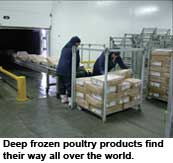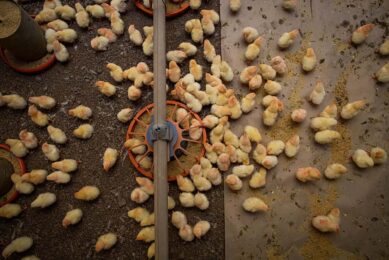Shifts and patterns in global poultry meat trade

There was a dramatic change in poultry meat production worldwide between 1990 and 2007. These developments, which greatly determined changing global trade patterns, were analysed in the first part of this article in the previous edition of World Poultry. This formed the basis of an analysis over this past period from a regional perspective, and an outlook until 2018.
By Dr. Barbara Grabkowsky and Dr. Prof. Hans-Wilhelm Windhorst, University of Vechta, Germany
In 1990, global beef exports were still much higher than pork and poultry meat exports. In the following 16 years, the contribution of the meat types to the global trade volume changed considerably. Between 1990 and 2006, mainly a result of the very high growth rates in chicken meat trade, the trade volume of pork increased from 2.8 to 7.8 million tonnes, or by 175%, and poultry meat from 2.7 to 11.0 million tonnes, or by 313% (Figure 1). This expansion reflects the dynamics in poultry meat production. Beef only ranked in third place with a trade volume of 6.3 million tonnes. Quite obviously, this sector has not yet completely recovered from the BSE crisis.
Between 1990 and 2006, the volume of global poultry meat exports increased by 8.4 million tonnes. In the same period, imports grew from 2.7 to 10.6 million tonnes. Europe lost 21% of its former share of global exports. Additionally, the gap between the export volumes of Latin America and North America has become much smaller (Table 1). Meanwhile, the contribution of North America to global exports increased by 4.9% and that of Latin America by 16.2%. The shifts in poultry meat imports were not that dramatic. Here, European countries still rank far ahead of Asian importing countries (Table 2).
Poultry meat basic food
The analysis of the leading poultry meat exporting and importing countries shows that regional concentration is much higher in exports than in imports (Table 3). Quite obviously, poultry meat has become a basic food – it is a quality protein product at relatively low price. Also, as there are hardly any religious taboos regarding this type of meat, a growing number of countries import poultry meat because they are not able to meet the increasing demand by means of domestic production. The fact that five of the leading exporting countries are located in Europe documents the leading role of this continent, even though their export volumes are much lower than that of the two American countries. Russia and Japan are located in the first two positions in poultry meat imports. Russia has not yet reached its former production volume, and Japan is hardly able to increase its domestic production because of high production costs and the lack of space for large production units. China and Hong Kong rank well in exports and in imports, which is due to the fact that large amounts are traded between Hong Kong and mainland China.
When looking at poultry meat exports and imports on the level of the continents, Asia had the highest deficit with almost 2.5 million tonnes in 2006, whereas Latin America and North America the highest surplus with 2.7 and 2.2 million tonnes, respectively (Figure 2).
A list of the five countries with the highest poultry meat surplus or deficit reveals that in 2006 Brazil and the US had the highest surplus with almost 3 and 2.9 million tonnes, respectively (Table 4). The deficits were highest in Russia, Japan and Mexico.
Regional meat trade patterns
In order to understand the surplus, respectively deficit regions, one needs to consider each region individually.
Highest surplus in Americas
In 2006, the countries in North and South America had a trade surplus of almost 5 million tonnes. This was highest in South America, followed by the three NAFTA member countries. Central America and the Caribbean were deficit regions.
A detailed analysis on country level (Table 5) shows a high regional concentration in exports as well as in imports. The export volume of Brazil and the US were almost identical, and together contributed 94.1% to the export volume of the Americas. Mexico ranked first among the leading poultry meat importing countries with a share of 45.4%, followed by Canada, Cuba and the US. It is obvious that the trade between the three NAFTA member countries is of utmost importance. Mexico was the leading country of destination for US exports. Brazilian exports went to East and West Asia as well as to adjacent countries in South and Central America.
Deficit in Europe
In spite of a production volume of 13.3 million tonnes, European countries were not able to meet domestic demand in 2006. The trade deficit amounted to 1.3 million tonnes, with the highest in Eastern Europe with 1.5 million tonnes and Northern Europe with 0.4 million tonnes; only Western European countries showed a surplus of 0.7 million tonnes.
The analysis on country level reveals that the regional concentration in poultry meat exports was higher than in imports (Table 6). It is obvious that many countries were not able to meet the increasing demand with domestic production. The Netherlands contributed 26% to the total export volume, followed by France, Belgium and Germany. These four countries shared 63% of the European exports. Russia imported 1.3 million tonnes of poultry meat in 2006, which was 27.2% of the total import volume. The United Kingdom and Germany ranked on second and third position, respectively. It will be of interest to see if Russia will be able to increase domestic production in such a way that it will not have to import poultry meat from 2010 on, as was announced by the ministry of agriculture in 2003. This would have far reaching impacts on the exports of Brazil and the US, but also hit several European exporting countries. The present economic and financial crisis, however, makes it very unrealistic that Russia will be able to expand its production by 1.3 million tonnes in a few years.
Highest deficit in Asia
In 2006, the Asian poultry meat deficit was almost as high as 2.5 million tonnes. East Asia had a deficit of 1.5 and West Asia 1.1 million tonnes. Only Southeast Asia showed a surplus of 266,000 tonnes.
A detailed analysis of the 10 leading exporting and importing countries shows a high regional concentration (Table 7). China, Thailand and Hong Kong ranked in the first three positions of the leading exporting countries. Together they shared about 91% of all exports. One has to consider, however, that there are close trade relations between mainland China and Hong Kong. About 320,000 tonnes of Hong Kong’s imports were re-exported to mainland China. Outbreaks of Avian Influenza in Thailand led to a collapse of its exports. In 2008, only 8,000 tonnes of frozen poultry meat could be exported, and in 2003 the export volume had reached 343,500 tonnes. To stabilise the poultry industry, Thailand began exporting cooked poultry meat. The composition and ranking of the leading importing countries reflects the high deficits in Eastern and Western Asia. Japan ranked first with an import volume of 887,000 tonnes, followed by China, Hong Kong, Saudi Arabia and the United Arabian Emirates. How exports and imports will develop in Eastern and South-eastern Asia will above all depend on the ability of the countries to control a further possible Avian Influenza virus outbreak. Recent outbreaks in Vietnam and Thailand showed that this will not be an easy task.
Oceania hardly integrated
Because of its peripheral location and small population, Oceania is hardly integrated in global poultry meat trade. In 2006, the trade deficit was as high as 12,000 tonnes. Australia and New Zealand had a poultry meat surplus of 27,000 tonnes, however, all other sub-regions of the continent were not able to meet demand by domestic production. Polynesia had the highest deficit with 23,000 tonnes. Imports came from Australia, New Zealand, Brazil, Argentina and the US.
Africa depends on imports
With a deficit of 681,000 tonnes, Africa ranked third behind Asia and Europe in 2006. In spite of a production volume of 3.6 million tonnes, many African countries were not able to meet the increasing demand with domestic production. All African sub-regions had a negative trade balance, South Africa (-268,000 t) as well as Central (-139,000 t) and East Africa (-137,000 t) had the highest deficits. Because of the growing demand, exports were of minor importance, only South Africa exported 5,600 tonnes. This country also ranked in first position regarding imports with 264,000 tonnes, followed by Angola and Ghana. These three countries shared almost two thirds of the total African import volume. It can be expected that imports will increase over the coming years, particularly when per capita consumption increases in North Africa and the frequent outbreaks of Avian Influenza cannot be controlled.
Trade volume to increase
Global poultry meat production and trade show similar dynamics. In 2006, 11 million tonnes, or 12.8% of the production volume, were traded worldwide. Between 1990 and 2006, the spatial trade pattern changed considerably. Europe could not maintain its dominating position. Meanwhile, the trade volume is almost similar to that of North and South America. Because of the high growth rates in Brazil and several other countries it can be assumed that within a few years South America will surpass Europe. Regarding imports, European countries are still in a leading position, but an expanding middle class with a high buying power in several Asian threshold countries will result in growing imports. Brazil and the US will strengthen their leading position. Thailand will recover, but Avian Influenza outbreaks will remain a continuous threat. The EU will have to import poultry meat also in the future because of the increasing per capita consumption in Eastern European countries.
Fast recovery obvious
The Food and Agricultural Policy Research Institute (FAPRI) at the Iowa State University projected the broiler meat trade for selected countries between 2008 and 2018 (Table 8). FAPRI expects that the gap between the export volumes of Brazil and the US will further widen and reach almost 800,000 tonnes in 2018. This may also be a result of the announced merger of the two leading poultry meat producing companies Sadia and Perdigão to Brasil Foods in 2009. Russia will remain the leading importing country, followed by Japan, Mexico and China. For the latter and the Republic of Korea, the highest relative growth rates are projected. A decrease of the import volume is only expected for Russia and Ukraine.
The impacts of the recent economic and financial crisis on the mid-term development of poultry meat trade are difficult to prognose. Because of the comparatively low consumer price and lower production costs than for beef and pork, poultry meat will be less affected and recover faster than the other two meat types, thereby further increasing in popularity.
Join 31,000+ subscribers
Subscribe to our newsletter to stay updated about all the need-to-know content in the poultry sector, three times a week. Beheer
Beheer








 WP Admin
WP Admin  Bewerk bericht
Bewerk bericht